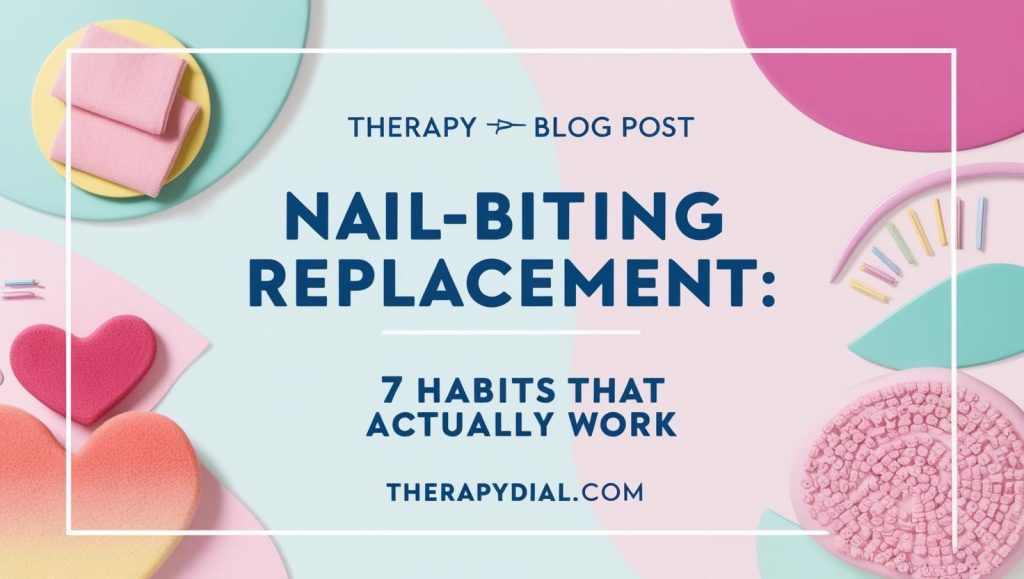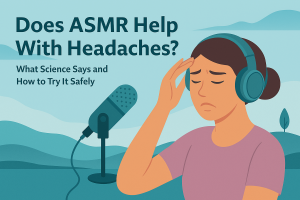Why Nail-Biting Happens: Stress, Boredom, and Habit Loops
Nail-biting might seem harmless—a quirky habit you’ve had since childhood. But for many people, it’s more than that.
It’s a compulsive behavior, a response to stress, anxiety, boredom, or even deep concentration. You might not even realize you’re doing it until your fingers are raw, your nails are gone, and your cuticles are bleeding.
Why does this happen? Because your brain has learned that biting brings temporary relief.
It fills space, releases tension, and gives your hands and mouth something to do. But it also damages your nails, leads to embarrassment, and creates a cycle that’s tough to break.
You’re not alone. Nail-biting is one of the most common Body-Focused Repetitive Behaviors (BFRBs), affecting people of all ages. And while it’s often brushed off as “no big deal,” it can take a real toll—physically, emotionally, and socially.
The Hidden Impact of Nail-Biting on Health and Confidence
Beyond the obvious damage to your nails, cuticles, and skin, nail-biting can lead to:
-
Infections from open skin and bacteria
-
Tooth or jaw issues due to repetitive biting
-
Gastrointestinal problems from ingesting bacteria
-
Shame and self-consciousness in social or professional settings
People often hide their hands, avoid nail salons, or wear bandages—not because they want to, but because they feel like they have to.
That’s why finding the right replacement habits matters. Not as punishment—but as tools to gently rewire your brain and give it what it’s really looking for: comfort, focus, and calm.
Let’s talk about why the urge happens—and what you can do that actually works.
Understanding the Urge
Nail-Biting as a Body-Focused Repetitive Behavior (BFRB)
Nail-biting is part of a larger group of behaviors called BFRBs. These include skin picking, hair pulling, and cheek biting—repetitive actions that cause physical damage and are hard to stop, even when you want to.
They’re not just habits—they’re often unconscious responses to:
-
Emotional triggers (like anxiety, frustration, or sadness)
-
Environmental triggers (like mirrors, screens, or quiet time)
-
Sensory triggers (like feeling rough edges or imperfections)
People with nail-biting BFRBs often report that the behavior:
-
Helps them concentrate
-
Eases nervous energy
-
Provides a sense of control
-
Just feels “right” in the moment
But after the moment passes, the regret kicks in—and so does the damage.
What Triggers Nail-Biting? Emotional and Sensory Drivers
Understanding why you bite is the first step to replacing it.
Common triggers include:
-
Stress or overwhelm (tests, work, social anxiety)
-
Boredom (long car rides, waiting, zoning out)
-
Perfectionism (trying to fix rough edges or uneven nails)
-
Fatigue or distraction (biting during homework or watching TV)
Sensory triggers matter too. You might bite because:
-
Your nails feel uneven or rough
-
You feel something “wrong” with a cuticle
-
You crave oral input (something in your mouth)
Knowing what sets you off helps you choose the right replacement tools—which we’ll cover shortly.
Breaking the Cycle: Why Replacements Matter
Why “Just Stop” Doesn’t Work
Here’s the truth: Willpower alone won’t fix nail-biting.
Your brain is wired to seek comfort and routine. If biting has become a go-to for stress or sensory input, then telling yourself to “just stop” is like telling a nervous system to chill out on command. It’s not fair—and it usually doesn’t work.
Stopping the behavior requires interrupting the pattern and offering your brain an alternative. Something that gives your hands and mouth what they’re craving—but without the damage.
That’s where smart, satisfying, science-backed substitutions come in.
How Substitution Rewires Your Brain
When you replace nail-biting with a healthier behavior, you begin to:
-
Reduce the reward of biting
-
Build new neural pathways for comfort
-
Change your muscle memory
-
Create new rituals that support your mental health
It’s not about quitting cold turkey—it’s about creating a soft landing for your urges.
Now let’s get into the replacements that actually work—and how to make them part of your daily life.
7 Nail-Biting Replacements That Actually Work
1. Chewelry and Oral Fidgets
Best Picks for Teens and Adults
If part of your nail-biting urge is rooted in oral fixation—meaning you need something in your mouth to chew, bite, or gnaw on—then chewelry (chewable jewelry) is your new best friend.
Chewelry comes in adult-friendly styles like:
- Silicone necklaces that look like dog tags or beads
- Chewable pencil toppers for students
- Discreet pendant chews worn under your shirt
You can also try:
- Chew sticks (similar to teething tools, but for adults)
- Reusable silicone straws for light biting
- Chew-safe gum with a strong texture
When to Use Them
Use oral fidgets when:
- You feel the urge to bite your nails
- You’re stuck in traffic, a meeting, or class
- You’re feeling anxious or overstimulated
- You’re about to zone out while reading or watching something
The key is proactive use. Don’t wait until you’re chewing a nail—keep your fidget handy so you can reach for it the second the urge hits.
Over time, your body will start preferring the alternative because it’s safer, more satisfying, and less guilt-inducing.
2. Cuticle Fidget Tools
Silicone Rings, Sensory Rollers, and Safe Pickers
Sometimes, the urge isn’t in your mouth—it’s in your fingers. You might feel driven to “fix” a hangnail or rough edge, or need the repetitive motion of scraping or picking.
Cuticle-friendly fidget tools can redirect this energy:
- Textured thumb rings – spin or rub instead of picking
- Silicone finger covers – massage and stimulate cuticles
- Sensory rollers – roll gently along your fingers
- Soft-tipped cuticle pushers – simulate the motion safely
These tools feel familiar to your fingers—but without causing damage. And unlike biting, you stay in control.
How to Use Without Drawing Attention
You don’t have to make it obvious. Most of these tools are:
- Silent
- Discreet
- Look like jewelry or common objects
Keep them in your pocket, pencil case, or keychain. Even massaging lotion into your cuticles for 30 seconds can satisfy the need for hand-based sensory input.
Think of it this way: your fingers are trying to do something. Let them—but safely.
3. Bitter-Tasting Nail Polishes
How Aversion Therapy Can Help Break the Habit
This classic nail-biting deterrent works through taste aversion. The polish tastes bitter and unpleasant, reminding you to stop every time your fingers get near your mouth.
Popular options include:
- Mavala Stop
- Onyx Stop the Bite
- Control-It! by Probelle
These formulas are non-toxic, clear, and safe for teens and adults. The taste is enough to interrupt the habit without being overwhelming.
For some people, this approach works almost immediately. For others, it’s most effective when combined with replacement tools, like fidgets or chewables.
Best Brands and Application Tips
- Apply once per day (or more if you wash your hands often).
- Pair with moisturizing hand cream—less dryness means less temptation.
- Use on both fingernails and cuticles if you tend to bite both.
- Keep a bottle in your bag or locker for reapplication.
Bonus tip: Make it part of your morning ritual—apply it before stressful moments, like exams, social events, or travel.
4. Stimulating Chewing Alternatives
Gum, Mints, and Crunchy Snacks
Sometimes, nail-biting is simply your body looking for something to chew—especially during stress or boredom. Instead of fighting the urge, try redirecting it with oral stimulation that’s satisfying, safe, and flavorful.
Smart substitutions include:
- Sugar-free gum – gives your mouth something to do
- Crunchy snacks – like baby carrots, celery sticks, or pretzels
- Strong mints or lozenges – extra flavor = extra sensory distraction
- Licorice root sticks – natural and great for oral fixations
These options work best when chewing feels soothing, and especially during idle moments like studying, working, or watching TV.
Mindful Chewing for Oral Sensory Regulation
Turn chewing into a mindful moment. When you feel the bite urge:
- Pop in gum or a mint
- Focus on the texture and flavor
- Take a few deep breaths while chewing
- Keep your hands busy with a fidget
This helps regulate your nervous system and distract your brain from biting impulses.
Bonus: keep a “chew kit” nearby—snacks, gum, or mints in a pouch for on-the-go relief.
5. Nail Art and Nail Care Rituals
Building Attachment to Nail Health
One of the best ways to stop biting is to fall in love with your nails. When you invest time, effort, and pride into how they look and feel, you’re more likely to pause before biting.
Try:
- DIY manicures at home (buffing, moisturizing, painting)
- Nail wraps or stickers
- Press-on nails (they physically block biting!)
- Non-toxic polish in colors you love
- “Nail growth serum” as a daily ritual
Even simple self-care like hand cream or cuticle oil builds a protective relationship with your nails—and helps you reconnect with your body in a positive way.
Nail Wraps, Press-Ons, and DIY Manis
These options are more than cosmetic—they’re behavior barriers:
- Nail wraps smooth out roughness = fewer triggers
- Press-ons make it physically harder to bite
- Shiny or bright polish makes you notice your nails more
- Clear coats make biting feel less “satisfying”
If you bite during stress, try turning nail care into a relaxing ritual—a time to check in with yourself and refocus your energy.
6. Wearable Barriers and Nail Covers
Physical Disruption for High-Stress Moments
Sometimes the only thing stopping a habit is a physical reminder. Nail covers, gloves, or even bandages can interrupt the behavior long enough to build new habits.
Options to try:
- Gel nail caps or silicone finger sleeves
- Cotton gloves for bedtime or homework time
- Cute bandages that act as visual and tactile blockers
- Nail wraps or false nails that feel too hard to bite
Wearable barriers are especially useful during:
- Study sessions
- Phone scrolling
- Bedtime routines
- Travel or stress events
Gloves, Wraps, and Acrylic Shields
You don’t have to wear gloves all day. Even using these tools for 30 minutes during trigger times can teach your brain: we don’t do that anymore.
Plus, these strategies can be styled to fit your vibe—use colors or textures you like. That way, it feels like self-expression, not punishment.
7. Journaling and Habit Tracking
Spotting Triggers and Celebrating Progress
Tracking your nail-biting may sound boring—but it’s actually a superpower. It gives you insights like:
- When you bite most (time, place, emotion)
- What helped you stop that day
- What tools you used or forgot to use
You’ll begin to see patterns—and progress.
Try this simple log:
- Date
- Number of bites or urges
- What triggered it?
- What helped me cope?
- What can I try next time?
Simple Templates and Tracking Tips
Use a printable habit tracker, journal app, or even a sticker chart. The goal is not perfection—it’s progress.
Bonus idea: start a “Nail Glow-Up” journal where you take weekly pics and write notes about what’s helping your growth journey. It’s incredibly motivating to see your nails heal—and realize you did that.
What to Do When the Urge Strikes
Grounding Techniques in the Moment
Urges don’t wait for the perfect time—they hit when you’re overwhelmed, bored, or stuck. Here are grounding strategies to redirect your brain and hands in real time:
- 5-4-3-2-1 Method: Name 5 things you see, 4 you feel, 3 you hear, 2 you smell, 1 you taste. It centers your mind instantly.
- Deep pressure: Squeeze a pillow, your hands, or use a weighted item like a lap pad.
- Cold shock: Hold an ice cube or run cold water over your hands—it interrupts the loop.
- Box breathing: Inhale for 4 seconds, hold for 4, exhale for 4, hold again—repeat until your brain settles.
The key is to act immediately when you feel the urge. Keep a mini toolkit (gum, fidget, lotion) nearby at all times so you can act instead of react.
Redirecting the Brain with Movement or Sensation
BFRBs are deeply tied to sensory seeking. So give your brain something even more engaging:
- Rub a textured cloth or soft brush
- Snap a slap bracelet
- Put on music and drum your fingers
- Squeeze a stress ball rhythmically
Movement breaks the autopilot. Sensory input calms the storm. Together, they reset the pattern.
When to Seek Help
Signs It’s More Than Just a Habit
If nail-biting is:
- Causing pain, bleeding, or infections
- Interfering with school, work, or relationships
- Making you feel ashamed, anxious, or out of control
- Hard to stop even with strong motivation
…it might be time to reach out for help.
Nail-biting can be a symptom of anxiety, OCD, ADHD, or sensory processing issues, especially if it’s paired with other BFRBs.
You’re not “too far gone.” You’re ready for more support—and that’s brave.
Therapies and Support Groups for BFRBs
Effective options include:
- CBT (Cognitive Behavioral Therapy) – targets thought and behavior loops
- HRT (Habit Reversal Training) – builds competing behaviors and awareness
- ACT (Acceptance and Commitment Therapy) – reduces shame, builds resilience
You can also find community in places like:
- The TLC Foundation for BFRBs
- Reddit’s r/nailbiting
- Instagram communities using #BFRBRecovery or #StopNailBiting
Conclusion
Nail-biting isn’t just a bad habit—it’s your brain reaching for comfort, control, and calm. And now, you’ve got a full toolkit of habits that actually work.
From fidgets and chewelry to tracking and self-care, these small steps add up to real change. You don’t need to “just stop”—you need to swap, soothe, and stay curious about what your body is asking for.
You deserve to feel good in your hands. To feel proud of your growth. And to know that every urge resisted, every healthy choice made, is a win.
Be patient. Be kind. And keep your hands (and mind) busy with what helps—not what hurts.
FAQs
How long does it take to stop nail-biting?
It varies! Some people see improvement in a week with the right tools, while others take months to fully rewire the habit. Progress is personal—track wins, not perfection.
Can nail-biting damage be reversed?
Yes! Nails, cuticles, and even minor scarring can heal over time with care, moisturization, and protection. Severe damage may benefit from dermatological support.
Are kids more likely to grow out of it?
Sometimes—but many kids carry it into adulthood without help. Teaching coping tools early on makes a big difference in long-term success.
What if nail-biting is linked to anxiety or OCD?
In that case, it’s part of a larger pattern—and therapy is highly recommended. CBT and HRT are proven to help manage both the urge and underlying anxiety.
Can nail-biting be treated without therapy?
Yes—many people succeed with tools, habit tracking, and support. But therapy can offer faster, deeper healing, especially for long-term or severe cases.
Learn More:
1. Understanding BFRBs – TLC Foundation
Explore expert guides on Body-Focused Repetitive Behaviors (BFRBs) and treatment options from the leading research organization.




